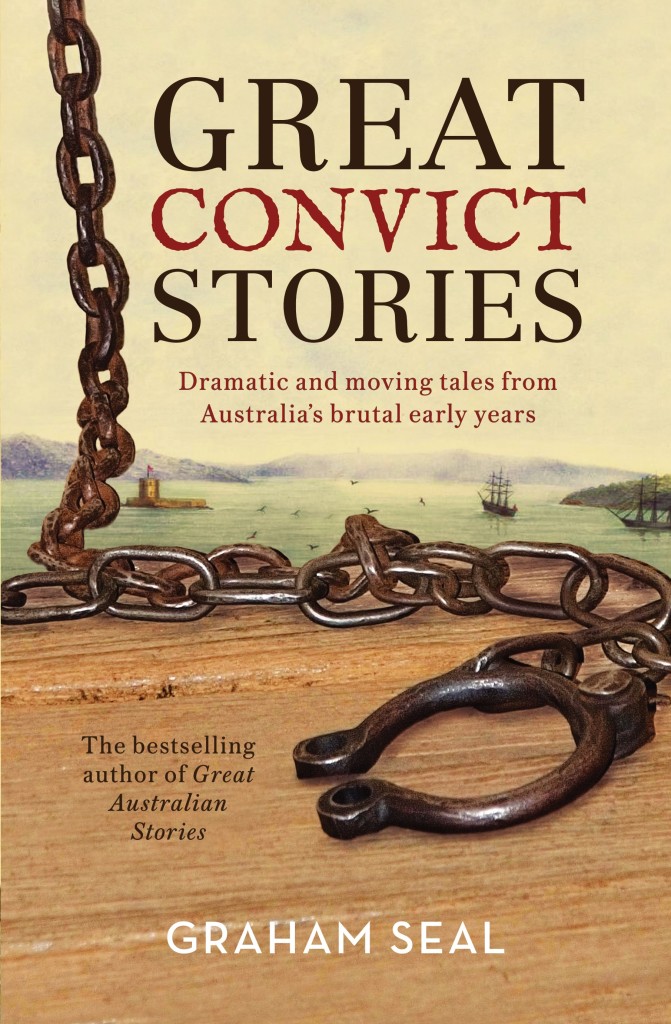‘Review note: Great Convict Stories by Graham Seal’, Honest History, 11 December 2017
This book contains about 85 little chunks of history (two to four pages each, mostly), bound into ten bundles, with seven to eleven chunks per bundle. The ten bundles are titled Unpromising Beginnings, Perilous Voyages, The Convict Underworld, The System, Pain and Suffering, Troublemakers, Places of Condemnation, Desperate Escapes, The Felonry, and A Convict Stain.
 This review note, succinct as it is, reflects the format of the book. Indeed, it is a prospectus rather than a full review, as the reviewer intends to read the book in full over a summer lazier and less hard-edged than the ones endured by Australia’s convicts.
This review note, succinct as it is, reflects the format of the book. Indeed, it is a prospectus rather than a full review, as the reviewer intends to read the book in full over a summer lazier and less hard-edged than the ones endured by Australia’s convicts.
A sample of six chunks, chosen for their intriguing titles, gives a further hint of what is in store for the summer reader: This Solitary Waste of the Creation (words from a letter written by an unidentified convict woman in the very early days of Port Jackson), Mrs Gravy’s Husbands (self-explanatory – Gravy was one of her married names), Hanged Three Times (also speaks for itself), Pluto’s Land (about Macquarie Harbour in Tasmania), The Legend of Margaret Catchpole (a Suffolk woman, who became very afraid of the Aboriginals of Port Jackson after being transported for stealing a horse), and The Gundagai Cat (a counterpoint to the Dog on the Tuckerbox).
There is a four page introduction, sketching who the convicts were, the attitudes they allegedly passed down to us, the types of stories they generated, the violence they suffered on the way here and after they arrived and, finally, how free settlement came about. Two points leap out. First, there is Seal’s careful use of the word ‘often’, as in ‘the dislike of authority often associated with our national identity’ (emphasis added). That ‘often’ word allows for a bit of leeway to accommodate other traits, for example, what Alan Davies many years ago identified as Australians’ ‘characteristic talent for bureaucracy’. Nor does ‘dislike of authority’ sit well with our mostly supine acceptance of our current governments’ increased security powers.
Seal also detects as a convict legacy ‘a larrikin sense of humour we value and often practise’. Some of us would put the ‘often’ in front of the word ‘value’, as well. Some of us would say ‘misogynist’, ‘racist’, ‘juvenile’, rather than larrikin – or give all of these adjectives a guernsey. Others of us would find equivalents in other countries of our larrikinism, just as Carmen Lawrence, in her chapter in The Honest History Book, found ‘Aussie’ egalitarianism – a close relative of larrikinism – replicated in other settings.
Further, Seal mentions ‘the convict stain’, that birthmark which Carolyn Holbrook (Anzac: The Unauthorised Biography) and others have suggested was washed away by the waters of the Dardanelles in 1915. ‘Australians have only recently’, suggests Seal, however, ‘begun to confront what was once considered a blot on the national story’. He notes particularly the reluctance of earlier generations to admit their convict forebears. Which makes Gallipoli a trifle ambivalent: washing away without admitting the stain that was being removed. Makes us sound very deep.
Seal’s chunks are finely carved, well-written, carry their evidence lightly without the burden of footnotes but with endnotes and sources, further reading, and a glossary. There is a map of convict locations. The book is nicely bound and packaged.
Yet, even with all the evidence, I wonder whether we will ever get closer to the convict experience and what it means today than through the mournful words of the song ‘Moreton Bay’, here given two alternative titles by the meticulous Seal, and ending thus: ‘And when from bondage we are liberated/Our former sufferings will fade from mind’. I recall ‘Moreton Bay’ being sung by Bobbi Gledhill at a mass meeting in Childers Street Hall, Canberra, a couple of days after the Dismissal in 1975. On those final lines Gledhill raised her chained hands above her head and broke the chain. Just for a moment, an instant, there was revolution brewing in that old timber hall. There are many legacies from the convict era.


Leave a Reply
You must be logged in to post a comment.